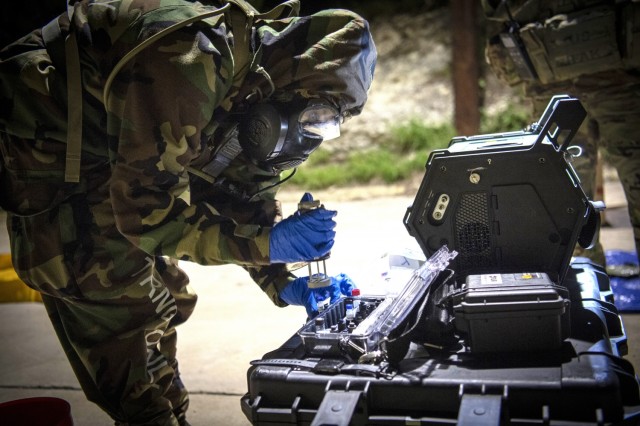

FORT HOOD, Texas — Soldiers from Fort Bragg, North Carolina, Joint Base Lewis-McCord, Washington, Marines from Camp Lejeune, North Carolina, and Airmen from Joint Base-Charleston, South Carolina teamed here to test new chemical agent detection systems.
Warfighters from across the nation conducted operational testing of the new systems between October and November. Through these Warfighters’ efforts, data was collected for decision-makers and valuable hands-on training was performed.
Soldiers with the 21st Hazard Response Company and 11th Chemical, Biological, Radiological and Nuclear (CBRN) Company along with Marines from the 2nd Marine Logistics Group and Airmen from the 628th Civil Engineer Squadron went hands-on with the Aerosol and Vapor Chemical Agent Detector (AVCAD) and the Multi-phase Chemical Agent Detector (MPCAD).
“As a Hazard Assessment Platoon, seldom are we presented the opportunity to focus on in-depth surveillance, characterization, and exploitation of realistic CBRN threats,” said 1st Lt. Matt Lohff, Platoon Leader of 3rd Platoon, 21st CBRN Hazard Response Company, 83rd CBRN Battalion.
“These two operational tests have given my platoon the opportunity to focus on our critical wartime collective tasks of dismounted CBRN reconnaissance and surveillance,” Lohff continued.
“The amount of hands-on training and employment opportunities we received really gave all of us confidence in the equipment and our capabilities with respect to our operational readiness.”
According to Mr. Joe Scheerer, test officer with the U.S. Army Operational Test Command’s Maneuver Support and Sustainment Test Directorate, test data and feedback collected informs senior Joint Service leaders on the effectiveness, suitability, and reliability of the AVCAD and MPCAD systems.
Scheerer explained during the 10-day record test, the Soldiers, Airmen, and Marines deployed the systems, analyzed chemical threat samples, provided detailed warning and reports, and conducted decontamination using the systems over 18 varying threat targets.
“CBRN site assessment and surveillance operations are complex missions that require our Joint Service CBRN assets to remain equipped with systems that are effective and suitable in Warfighter’s hands,” Scheerer said. “This test event is about making sure the systems developed provide proper capabilities in the environments in which Warfighters and units train and fight.”
~~
About the U.S. Army Operational Test Command:
As the Army’s only independent operational tester, USAOTC enlists the “Total Army” (Active, National Guard, and Reserve) when testing Army, joint, and multi-service warfighting systems in realistic operational environments, using typical Soldiers to determine whether the systems are effective, suitable, and survivable. USAOTC is required by public law to test major systems before they are fielded to its ultimate customer — the American Soldier.
The Maneuver Support and Sustainment Test Directorate conducts operational tests of combat engineer, chemical, transportation, military police, quartermaster, ordnance and medical service systems in order to provide our senior leaders with the necessary information to field the highest quality equipment for the warfighter.


Social Sharing